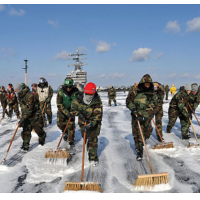More than 70 Radiation-Stricken U.S. Sailors Sue Fukushima Plant Operator
 USS Ronald Reagan washdown after Fukushima
USS Ronald Reagan washdown after Fukushima
At least 71 U.S. Navy personnel are suing the operator of the Fukushima Daiichi nuclear power plant for exposing them to harmful levels of radiation following the 2011 earthquake and tsunami.
The sailors became exposed to radiation leaking from the crippled power plant when their ships arrived off Japan’s coast to provide humanitarian assistance. They remained in the area for four days.
The American men and women say they are suffering from radiation exposure and numerous health problems brought on by the exposure. These include leukemia, testicular cancer, gynecological bleeding and thyroid diseases.
Their attorney, Paul Garner, says that at least half of the plaintiffs have some form of cancer.
Senior Chief Michael Sebourn, a radiation-decontamination officer on board the aircraft carrier USS Ronald Reagan, told the New York Post that radiation levels in the air were far above normal, and at one point eclipsed 300 times the safety limit.
Exposure was both air-borne and water-borne, according to the lawsuit.
At one point, radioactive snow—created by the mixing of contaminated steam from the nuclear plant with cold Pacific Ocean air—fell on the ships, exposing sailors topside.
But the seawater surrounding the vessels was also radioactive as a result of coolant leaks at Fukushima. That water was drawn into the Ronald Reagan’s desalinization system, which provides water for drinking and bathing by the crew.
“We were probably floating in contaminated water without knowing it for a day and a half before we got hit by that plume,” Lindsay Cooper, whose career as a third-class petty officer ended five months after the disaster for health reasons, told the Post.
She added that the radiation exposure crippled her thyroid, making it “so out of whack that I can lose 60 to 70 pounds in one month and then gain it back the next. My menstrual cycle lasts for six months at a time, and I cannot get pregnant. It’s ruined me.”
By the time the crew realized the water they were using was contaminated, the radioactive plume had hit and they were unable to maneuver the aircraft carrier to outrun it. Japan refused them entry at port, and they were turned away by both Guam and South Korea. The ship floated at sea in the radioactive waters for two-and-a-half months, during which time the sailors became increasingly ill. They were finally allowed to make port in Thailand.
Decontamination officer Sebourn—who previously worked as a personal trainer—has suffered severe effects from the radiation, including nosebleeds, headaches, shrunken limbs, and the loss of 60% use of the right side of his body. “I’ve had four MRIs, and I’ve been to 20 doctors,” he told the Post. “No one can figure out what is wrong.” He has since retired from the Navy.
“This [lawsuit] isn’t about financial gain,” Cooper told the newspaper. “This is about what’s going to happen while I’m sick, and then after I’m gone. I worry because I have a daughter. And I’m so sick.”
The sailors’ lawsuit was filed against the Tokyo Electric Power Company, which operates the Fukushima power plant.
-Noel Brinkerhoff, Danny Biederman
To Learn More:
Navy Sailors have Radiation Sickness after Japan Rescue (by Laura Italiano and Kerry Murtha, New York Post)
70+ USS Ronald Reagan Crew Members, Half Suffering From Cancer, to Sue TEPCO For Fukushima Radiation Poisoning (by Brandon Baker, EcoNews)
8 U.S. Sailors Stationed in San Diego Sue Japanese for Lying about Radiation at Fukushima Plant (by Noel Brinkerhoff and David Wallechinsky, AllGov)
- Top Stories
- Unusual News
- Where is the Money Going?
- Controversies
- U.S. and the World
- Appointments and Resignations
- Latest News
- Musk and Trump Fire Members of Congress
- Trump Calls for Violent Street Demonstrations Against Himself
- Trump Changes Name of Republican Party
- The 2024 Election By the Numbers
- Bashar al-Assad—The Fall of a Rabid AntiSemite






Comments